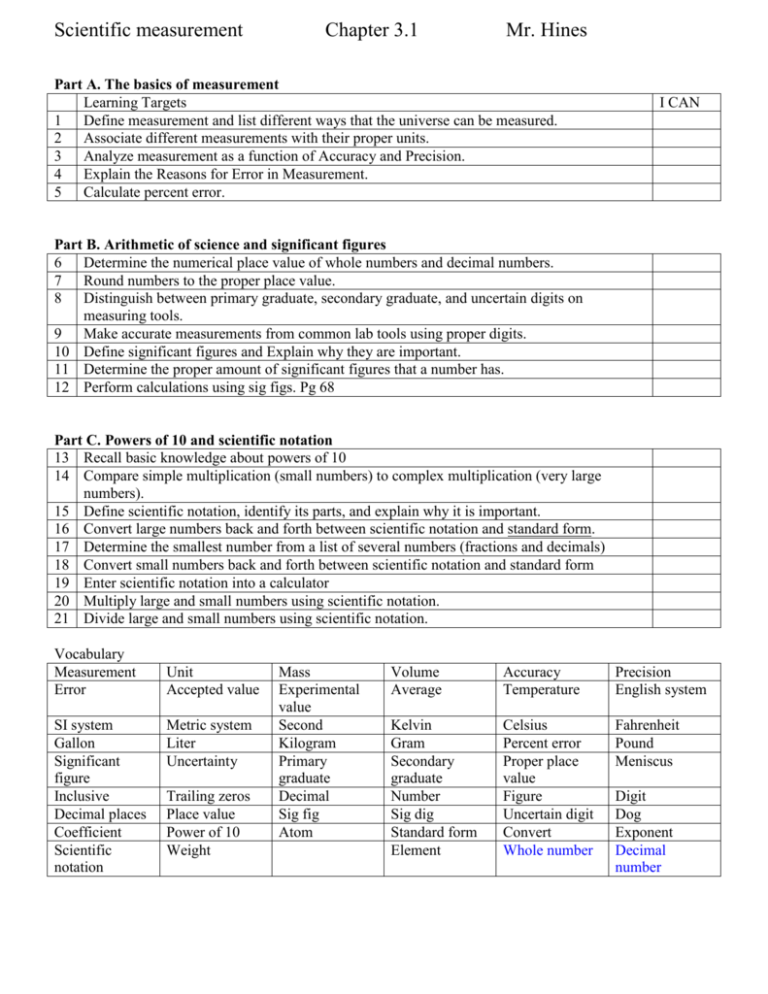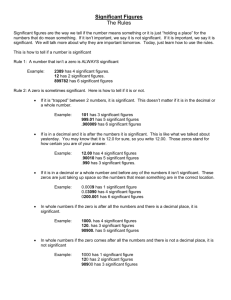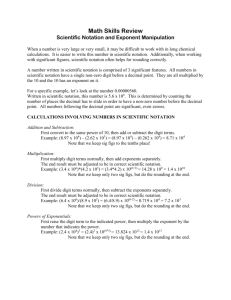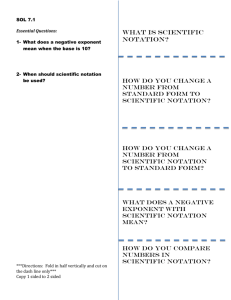
Scientific measurement
Chapter 3.1
Mr. Hines
Part A. The basics of measurement
Learning Targets
1 Define measurement and list different ways that the universe can be measured.
2 Associate different measurements with their proper units.
3 Analyze measurement as a function of Accuracy and Precision.
4 Explain the Reasons for Error in Measurement.
5 Calculate percent error.
I CAN
Part B. Arithmetic of science and significant figures
6 Determine the numerical place value of whole numbers and decimal numbers.
7 Round numbers to the proper place value.
8 Distinguish between primary graduate, secondary graduate, and uncertain digits on
measuring tools.
9 Make accurate measurements from common lab tools using proper digits.
10 Define significant figures and Explain why they are important.
11 Determine the proper amount of significant figures that a number has.
12 Perform calculations using sig figs. Pg 68
Part C. Powers of 10 and scientific notation
13 Recall basic knowledge about powers of 10
14 Compare simple multiplication (small numbers) to complex multiplication (very large
numbers).
15 Define scientific notation, identify its parts, and explain why it is important.
16 Convert large numbers back and forth between scientific notation and standard form.
17 Determine the smallest number from a list of several numbers (fractions and decimals)
18 Convert small numbers back and forth between scientific notation and standard form
19 Enter scientific notation into a calculator
20 Multiply large and small numbers using scientific notation.
21 Divide large and small numbers using scientific notation.
Vocabulary
Measurement
Error
SI system
Gallon
Significant
figure
Inclusive
Decimal places
Coefficient
Scientific
notation
Unit
Accepted value
Metric system
Liter
Uncertainty
Trailing zeros
Place value
Power of 10
Weight
Mass
Experimental
value
Second
Kilogram
Primary
graduate
Decimal
Sig fig
Atom
Volume
Average
Accuracy
Temperature
Precision
English system
Kelvin
Gram
Secondary
graduate
Number
Sig dig
Standard form
Element
Celsius
Percent error
Proper place
value
Figure
Uncertain digit
Convert
Whole number
Fahrenheit
Pound
Meniscus
Digit
Dog
Exponent
Decimal
number
Part A – THE BASICS OF MEASUREMENT
Target 1 - Define measurement and list different ways that the universe can be
measured. Pg 64
A. Measurement - a quantity that has both a number and a ________.
1. For example, how much do you weigh? _________________
2. In order for this to be a proper measurement, it must contain a number and a unit.
B. Science is very dependent on measurements.
C. Every time a scientist performs an experiment, something is being _____________________.
D. The four things in the universe are commonly measured in chemistry.
1. Matter – measured as ____________ or weight
2. Space – measured as _____________
3. Energy – measured as ____________________ ______ (energy has other measurements)
4. Time – measured as ____________
Target 2 - Associate different measurements with their proper units. Pg 73
A. The universe can be measured using many units.
B. There are 3 systems for making measurements.
1. English System - used only in the United States
2. Metric System - Used around the world
3. SI System – Used around the world in science (SI stands for “System International”)
1.
2.
3.
4,
Universe
Matter
Space
Energy
Time
Measurement
Mass (weight)
Volume
Temperature
Time
English unit
Metric unit
SI unit
Target 3 - Analyze measurement as a function of Accuracy and Precision. Pg 64
A. Accuracy – the closeness of a measurement to the true value of what is being measured.
B. Precision – the reproducibility of a measurement when it is repeated.
Consider the example below:
3.1
Measurements and Their
Uncertainty
>
Accuracy, Precision, and Error
Slide
9 of 48
© Copyright Pearson Prentice Hall
Target 4 - Explain the Reasons for Error in Measurement. Pg 64
A. Accuracy in measurements
1. All sciences rely on ___________________________.
2. Human beings of course are the ones who make the measurements.
3. Human beings are imperfect and make ____________________.
4. When mistakes are made, it is called ERROR.
5. Error – mistake or accidental incorrectness
6. When humans make measurements, there are 2 factors that can cause ________________.
a. The ability to properly read a measuring tool
b. The quality of the measuring tool
B. These 2 scenarios can both lead to ERROR
1. Example 1: A person can have a very accurate measuring tool and not know how to use it
2. Example 2: A person can be very skilled at measuring, but have poor measuring tools
Target 5 - Calculate percent error. Pg 65
A. Percent error
1. Percent error - a calculation that determines the accuracy of a person’s measurement.
2. In other words, it can determine how “_________________” or “incorrect” a measurement is.
3. There are 2 terms that you need to know in order to calculate percent error.
a. accepted value
b. experimental value
4. Accepted value – the correct value based on __________________ information. Information listed on a
label of something is generally an accepted value.
5. Experimental value – a value that is measured in a lab (__________________).
B. Calculations
1. When taking scientific measurements, human beings make errors. The amount of error can be
determined by simple mathematics.
Accepted value – Experimental value
____________________________________
Accepted value
x 100
2. This number should be written as a percent and gives a scientist an idea how accurate s(he) was.
*** For example: The known value for the Lab table was 831 cm. Jack Belittle measured the lab table to be 913
cm. What is Jack’s percent error?
831 cm - 913 cm
___________________ x 100 = 9.87% (always use absolute value)
831 cm
Accepted Value
1) 255 milliliters
2) 78.4 grams
3) .000624 grams
4) 10.1 meters
5) .0675 liters
Experimental value
271 milliliters
82.6 grams
.000425 grams
9.12 meters
.0758 liters
Percent error
Questions
1. What is accuracy? _____________________________________________________
2. What is precision? _____________________________________________________
3. What do you think causes some percents to be negative?
_______________________________________________________________________
4. Jimmy Houston is at Kroger and buys a gallon of orange juice. When he gets home, he measures the
volume of the orange juice with various tools around the house. Jimmy’s measurement says that he has 1.2
gallons of orange juice.
a. What is the accepted value? ___________________
b. What is the experimental value? ___________________
5. What is the percent error of Jimmy’s measurement? Show your work.
__________________
PART B – THE ARITHMETIC OF SCIENCE AND SIGNIFICANT FIGURES
Target 6 - Determine the numerical place value of whole numbers and decimal
numbers.
A. Number - an expression that represents “the counting of” (includes all digits)
B. Whole number – digits __________ of the decimal point
C. Decimal number – digits following a decimal point (aka decimal place)
D. Place value – name of the place or location of a ____________ in a number
E. Figure – written symbol – usually a part of a number
F. Digit - written symbol – usually a part of a number
G. All figures (digits) will have a ____________________________.
Example 1
Notes
1234.5678
Example 2
8174.6352
1. What is the number listed in example 2? ______________
2. Which figure represents the hundreds place? _____
3. Which figure represents the tens place? ____
4. Which figure represents the ones place? ____
5. Which figure represents the tenth place? ____
6. Which figure represents the hundredth place? ____
7. Which figure represents the thousandth place? ____
8. What is the synonym for “figure?” _________________
Target 7 – Round numbers to the proper place value
A. Rounding numbers – process where the amount of figures in a number is properly __________________.
B. Proper place value – place value that you should round to.
C. There are 4 basic rules
1. The proper place value may or may not change.
2. The figure that follows the proper place value will determine how to round.
3. Figures between 1 and 4 cause no change and are simply removed.
4. Figures between 5 and 9 will cause the proper place value to increase by 1.
Number
1
Proper place Answer
value
Ones
Number
9
Ones
10
Ones
11
Ones
12
Tenth
13
Tenth
14
Tenth
15
Tenth
16
25.2
2
Ones
6.9
36.63
8
Tens
467.239
36.65
7
Hundredth
467.239
36.67
6
Hundredth
45.241
25.6
5
Hundredth
45.246
25.5
4
Answer
45.245
25.4
3
Proper place
value
Hundredth
Tenth
7.99
36.654
Hundredth
27.999
Target 8 - Distinguish between primary graduate, secondary graduate, and
uncertain digits on measuring tools.
Primary graduate - Bold numbers on a measuring tool
Secondary graduate - Divisions between Primary graduates
Uncertain digit – one tenth of the secondary graduate - estimated
RULER Z
Target 9 - Make accurate measurements from common lab tools using proper digits.
Website for practice: paccd.cc.ca.us/instadmn/physcidv/chem_dp/apps/MindYourSigFigs.html
Example 1:
___________________________
Correct measurement ________________________
Example 2:
_________
Correct measurement ________________________
Example 3:
_________________________________
Length
Station
Primary grad.
Secondary
grad.
Uncertain digit
Complete
measurement
Primary grad.
Secondary
grad.
Uncertain digit
Complete
measurement
Secondary
grad.
Uncertain digit
Complete
measurement
1
2
3
Volume
Station
4
5
6
Temperature
Station
Primary grad.
7
8
Be sure to include units in the last column. Units are indicated on the measuring device.
Target 10 - Define significant figures and Explain why they are important. Pg 66
A. Significant figure– a count of all the digits that can be known accurately in a measurement, plus a last estimated
digit
Ruler Z
B. Why are significant figures important?
1. Significant figures indicate the accuracy of the measurement. Example: Ted Wagner is a chemist in
California and Tyler Parker is chemist in New York. Ted uses ruler Z (example above) to measure the
length of the wooden object to be 6.37 meters. He sends the information to Tyler in New York. Tyler
knows that Ted was using an accurate measuring tool because Ted used 3 significant figures. More
specifically, Tyler knows that Ted used a measuring tool capable of measuring to the hundredth place.
2. Significant figures will eliminate unnecessary numbers after the decimal. For example, enter the this into
your calculator – 153 / 7
3. You don’t need all of these numbers… where do you cut them off?
C. Significant figures are important because they express the accuracy of a measurement. (decimal place value)
Target 11 - Determine the proper amount of significant figures that a number has.
1. All digits 1-9 inclusive are significant.
Example:
129 has 3 significant figures
2. Zeros between significant digits are always significant.
Example: 5007 has 4 significant figures
3. Trailing zeros in a number are significant only if the number contains a decimal point
Example: 100.0 has 4 significant figures.
100 has 1 significant figure.
4. Zeros in the beginning of a number whose only function is to place the decimal point are not
significant.
Example: 0.0025 has 2 significant figures.
5. Zeros following a decimal significant figure are significant.
Example: 0.000470 has 3 significant figures
0.47000 has 5 significant figures.
Rule 1
Number
1 4
Sig figs
Number
4 577
2
27
5 143644434
3
6722
6 5433
Rule 2
Number
1 202
Sig figs
Number
4 5000566
2
4009
5 3090805
3
609
6 700004002
Rule 3
Number
1 200
2
3000
Sig figs
Number
4 4000.
5 400000000000000
Sig figs
Sig figs
Sig figs
3
200.
6 800000.
Rule 4
Number
1 0.0034
Sig figs
Number
4 0.0034567
Sig figs
2
0.0669
5 .000000007
3
0.00078
6 .000000976507
Rule 5
Number
1 0.003400
Sig figs
Number
4 .0099002
2
0.98000
5 .030
3
.00990
6 .000040400
Sig figs
More practice
Sig Figs
Rule number
Sig Figs
1) 4
16) 24.30
2) 27
17) 2585
3) 6722
18) 23000
4) 202
19) 20330
5) 4009
20) .33900
6) 235019
21) .00339
7) 200
22) .0033900
8) 200.
23) 200054.00
9) 7000
24) 200.
10) 9000.
25) 3009
11) .02
26) 301.20
12) .0042
27) 123.04560
13) .000171
28) 3.000
14) .230
29) .00030
15) .7800
30) 000.0003
Rule number
Target 12 - Perform calculations using sig figs. Pg 68
A. Adding and subtracting sig figs.
RULE: When adding or subtracting, your answer can only show as many decimal places as the
measurement having the fewest number of decimal places. You must round to the proper place value.
Write the number of decimal places above each number and then perform the mathematics.
1) 4.60 + 3 =
7) 357.89 + 0.002
2) 0.008 + 0.05 =
8) 18.95 + 32.42 + 50 =
3) 22.4420 + 56.981 =
9) 5.5 + 3.7 + 2.97 =
4) 200 - 87.3 =
10) 4.675 - 3 =
5) 67.5 - 0.009 =
11) 75 - 2.55 =
6) 71.86 - 13.1 =
12) 10 - 9.9 =
B. Multiplying and Dividing Sig Figs
RULE: When multiplying or dividing, your answer may only show as many significant digits as the
multiplied or divided measurement showing the least number of significant digits.
Write the amount of sig figs above each number and then perform the mathematics –
1) 13.3 x 2.7 =
7) 50.0 x 2.00 =
2) 21.3 x 3.58 =
8) 2.3 x 3.45 x 7.42 =
3) 0.00003 x 727 =
9) 1.0007 x 0.009 =
4) 5003 / 3.781 =
10) 51 / 7 =
5) 89 / 9.0 =
11) 208 / 9.0 =
6) 5121 / 55 =
12) 0.0037 / 5 =
Re-run
1) 3.45 + 53.2529 + 0.601 =
5) 6.77 x 29.11 =
2) 74.160 - 4.8 - 0.470 =
6) 200.60 + 93 =
3) 2.15 x 3.1 x 100 =
7) 609.4443 / 82 =
4) 9634 / 6.002 =
203.3334 – 45.2 =
C. POWERS OF 10 AND SCIENTIFIC NOTATION
Target 13 - Recall basic knowledge about powers of 10
I. Powers of 10 – When a number is multiplied by 10, it becomes much larger – by a power of 10
A. Where is the decimal of all numbers if the decimal is not written?
1) 51
2) 368
3) 1
4) 900,000
5) 347,922,222
6) If a decimal is not shown, it is always to the right of the number furthest to the right.
B. What happens when a number is multiplied by a power of 10
1) 51 x 10 =
2) 368 x 10 =
3) 1 x 10 =
4) 900,000 x 10 =
5)347,922,222 x 10 =
6.) These are the same numbers listed– now where is the decimal
C. Where is the decimal?
*When a number is multiplied by 10, The decimal moves 1 digit to the right and a
zero is added. The examples below are the Same as above.
1) 51. x 10 = 510.
2) 368. x 10 = 3680.
3) 1. x 10 = 10.
4) 900,000. x 10 = 9,000,000.
5) 347,922,222. x 10 = 3,479,222,220.
6) So now each number is ten times larger than it was.
D. What about multiplying a number by 10, but twice?
1) 51 x 10 x 10 =
2) 368 x 10 x 10 =
3) 1 x 10 x 10 =
4) 900,000 x 10 x 10 =
5) 347,922,222 x 10 x 10 =
E. Now where is the decimal?
1) 51 x 10 x 10 = 5100.
2) 368 x 10 x 10 = 36800.
3) 1 x 10 x 10 = 100.
4) 900,000 x 10 x 10 = 99,000,000.
5) 347,922,222 x 10 x 10 = 34,792,222,200.
6) So every time you multiply by 10, you add a zero and move the decimal 1 place
to the right.
II. Exponents
A. How can 10 x 10 be written with an exponent?
1) 102
2) 10 x 10 and 102 are the same thing?
3) 10 x 10 = 100
4) 102 = 100
B. Try the same example as above
1) 51. x 102 =
2) 368. x 102 =
3) 1. x 102 =
4) 900,000. x 102 =
5) 347,922,222. x 102 =
6) Did you notice anything about the exponent and how many zeros you added?
C. What does the exponent tell you?
1) The exponent tells you how many zeros to add.
2) More specifically, the exponent tells you how many places you move the decimal.
D. Try these
1) 45 x 102 =
2) 367 x 102 =
3) 58888 x 102 =
4) .2 x 102 =
5) .67 x 102 =
E. Uh oh - advanced
1) 3.56 x 104 =
2) 347 x 103 =
3) .4554 x 107 =
4) .68334 x 103 =
5) 2 x 109 =
Questions
1. Where is the decimal of all numbers if it is not written? ______________________________
2. What does a power of ten tell you to do with the decimal? ____________________________
3. Rewrite 10 x 10 x 10 with an exponent? ____________________________
Target 14 – Compare simple multiplication (small numbers) to complex
multiplication (very large numbers).
Exercise A
Write the number sixty
Write the number four
Now multiply them
Answer
Exercise B
Write the number sixty billion
Write the number four million
Now multiply them.
Answer
Questions
1. How many zeros does your answer have from exercise A? ________
2. How many zeros does your answer have from exercise B? ________
3. Could this be done by counting zeros and using rules from the powers of 10? ______
4. Is there a short cut? ______
Target 15 - Define scientific notation, identify its parts, and explain why it is
important.
A. Scientific notation – method for writing very large and very small numbers so that they are easier to understand;
shortcut for writing large and small numbers.
B. Scientific notation always contains 3 parts.
1. Coefficient
2. Power of 10
3. Exponent
In each example, Label the coefficient, power of 10, and exponent
Example 1
Example 2
5.2 x 103
3.7 x 107
C. One important rule about the coefficient – It must be a number equal to or greater than 1 and less than ten.
D. Scientific notation is the product of 2 numbers (2 numbers multiplied)
E. Scientific notation is based on powers of ten.
F. Scientific notation is important because it makes large and small numbers easier to understand.
Questions
1. What is scientific notation? ________________________________________________________
2. What are the 3 parts of scientific notation? ____________________________________________
3. Why is scientific notation important? ________________________________________________
4. What is the one important rule about the coefficient? ____________________________________
Target 16 - Convert large numbers back and forth between scientific notation
and standard form.
Practice – these numbers are in scientific notation. Write them in standard form.
Scientific notation
Standard form
1
3.9 x 103
2
5.2 x 105
3
3.4 x 103
4
9.0 x 105
5
1.43 x 109
Practice – these numbers are in standard form. Write them in scientific notation.
Standard form
Scientific notation
1
30000
2
34000000
3
235000000
4
740000000000
5
500
Target 17 - Determine the smallest number from a list of several numbers
(fractions and decimals)
A. So far, the numbers have been very large. What about very small numbers.
Exercise 1 – Circle the smallest number
5
70
1
2544
2.3
7
677
3
9553.3
Exercise 2 – Write 3 numbers that are smaller than the smallest number circled above.
a)_______
b) ________
c) _________
Exercise 3 – Look at the 3 numbers that you listed in exercise 2 and circle the smallest number.
Exercise 4 - Write 3 numbers that are smaller than the smallest number circled above.
a)_______
b) ________
c) _________
Questions
1. How small can a number be? __________________________________________________
2. Circle the smallest number
.005
.00005
.0000000005
.00000000000005
.00000000000000000005
3. How were you able to tell which of the numbers listed above was the smallest? _______________
Target 18 - Convert small numbers back and forth between scientific notation
and standard form
I. Negative exponents
A. So far, our exponents have been positive numbers. What about negative exponents?
B. Positive exponents will tell you how many places to move the decimal point to the right.
C. You guessed it, Negative exponents will tell you how far to move the decimal to the left.
D. When the decimal is moved to the left, the number becomes smaller.
E. Try these – put these numbers in standard form.
1) 1.2 x 10-3 =
2) 5.4 x 10-4 =
3) 7834 x 10-7 =
4) 456633 x 10 -6 =
5) 35.33 x 10 -5 =
6) Remember, the negative exponent tells you how many places you move the decimal
to the left.
E. How about in reverse? Put these numbers in scientific notation.
1) .0006 =
2) .00005 =
3) .00034 =
4) .000000000000045 =
5) .000343334 =
Target 19 - Enter scientific notation into a calculator
A. Any scientific calculator will understand scientific notation if you use it correctly.
B. When entering scientific notation into a calculator, you must type in 3 things.
1. Coefficient
2. Power of 10
3. Exponent
C. In order to do this, you must find a special button on your calculator.
D. This button is called “the power of 10” button.
E. There are 2 common ways that calculators label this button.
EE EXP
F. Look for these buttons on your calculator. It should have one or the other, not both.
G. Once you have found the “power of 10” button, write the label here ________
H. There are 3 steps
1. Type in the coefficient
2. Hit the “power of 10” button
3. Type in the exponent
I. Type this number into your calculator.
4.45 x 1015
Target 20 - Multiply large and small numbers using scientific notation.
Notes
A. In order to multiply large numbers, you will need your calculator.
B. This is best learned by doing – Perform these exercises
C. Coefficients will determine sig figs.
1
[6.84 x 103] x [4.54 x 106]
3.12 x 1010
2
[2.0 x
10 11]
x [8.5 x
105]
1.7 x 1017
3
[4.42 x 10-6] x [8.67 x 10-7]
3.83 x 10-12
4
[3.7 x 10 9] x [7.3 x 10-2]
2.7 x 108
5
[8.77 x 1015] x [3.714 x 1019]
3.26 x 1035
6
[5.0 x 10 -2] x [7.85 x 1014]
3.9 x 1013
7
[1.042 x 10-11] x [4.002 x 10-15]
4.17 x 10-26
Important – There are other methods for performing this task on your calculator. In order to keep things simple,
only one method will be taught. Most of the time, when students use other methods, they get wrong answers. You
are strongly urged to use the method taught in class.
Target 21 - Divide large and small numbers using scientific notation.
1
2
3
4
5
6
7
[2.21 x 10 13] ÷ [1.44 x 103]
[1.92 x 10-2] ÷ [2.3 x 108]
[9.4 x 10 2] ÷ [1.24 x 10-9]
[9.2 x 10-3] ÷ [6.3 x 1016]
[2.4 x 10 6] ÷ [5.49 x 10-9]
[4.5 x 109] ÷ [2.45 x 10-4]
[3.6 x 10-6] ÷ [2.1 x 1015]
1.53 x 1010
8.3 x 10-11
7.6 x 1011
1.5 x 10-19
4.4 x 1014
1.8 x 1013
1.7 x 10-21
If your calculator is not working, here is how you do it by hand.
Rule for Multiplication - When you multiply numbers with scientific notation, multiply the coefficients together
and add the exponents. The base will remain 10.
Rule for Division - When dividing with scientific notation, divide the coefficients and subtract the exponents. The
base will remain 10.









